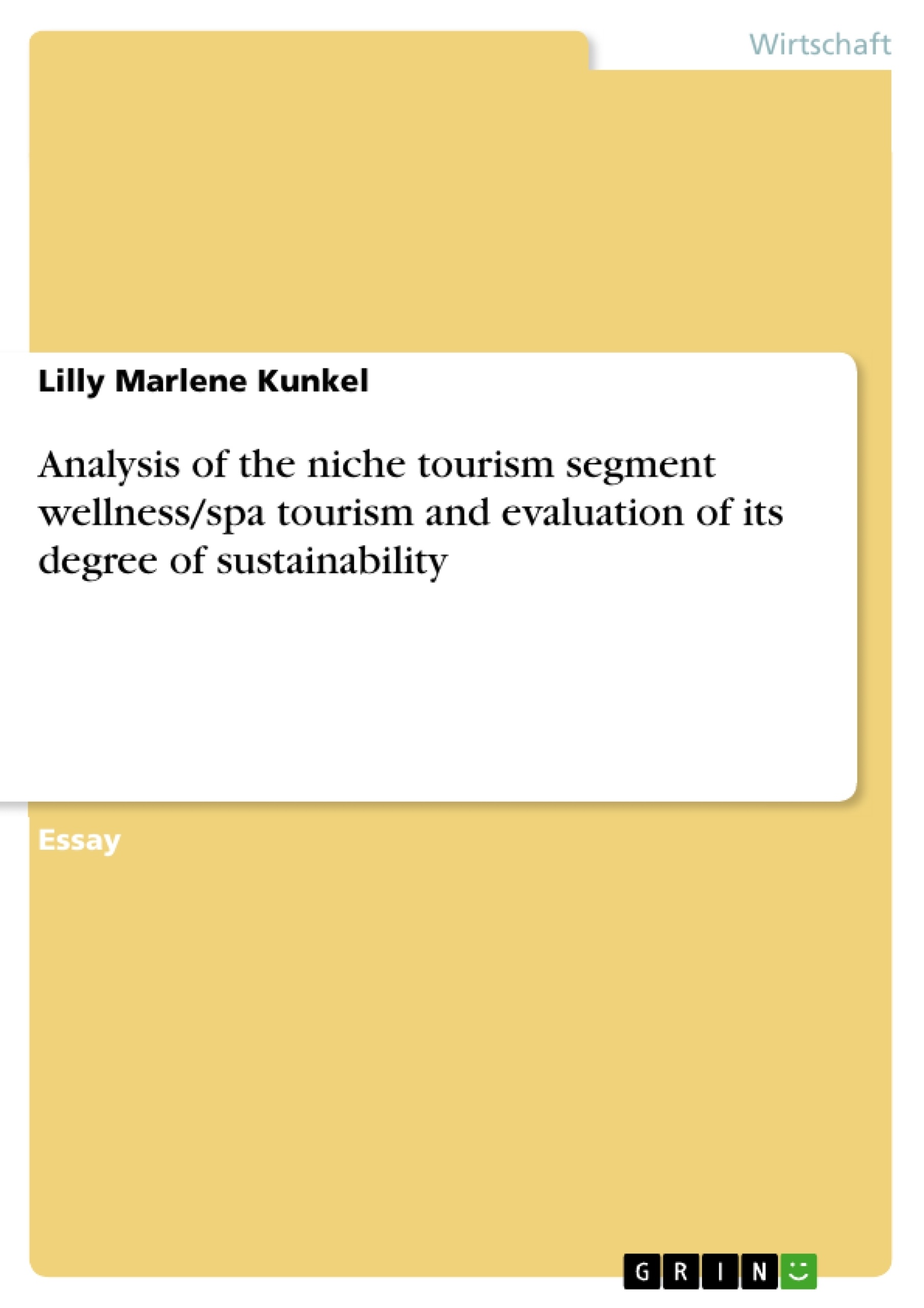The aim of this essay is, to evaluate the extent to which the lifestyle tourism sub-niche wellness/spa tourism is adequate as a tool for sustainable tourism development. To reach this aim, an examination of literature surrounding the fields of sustainability and wellness tourism will be undertaken and defined. Arguments for and against the sustainability and trends of the chosen niche segment will be discussed; mainly focussing on the case study of Nusa Dua on Bali, Indonesia, supported by other industry examples, and a final conclusion will be given.
Inhaltsverzeichnis
- Nachhaltige Entwicklung und nachhaltiger Tourismus
- Dimensionen nachhaltigen Tourismus
- Umweltdimension
- Wirtschaftsdimension
- Soziale Dimension
- Wellness- und Spa-Tourismus als Nische
Zielsetzung und Themenschwerpunkte
Diese Arbeit untersucht, inwieweit Wellness-/Spa-Tourismus als Instrument für eine nachhaltige Tourismusentwicklung geeignet ist. Hierfür werden zunächst die Konzepte nachhaltige Entwicklung und nachhaltiger Tourismus definiert und Argumente für und gegen die Nachhaltigkeit dieser Tourismusnische diskutiert. Der Fokus liegt auf einer Fallstudie in Nusa Dua auf Bali, Indonesien, ergänzt durch weitere Branchenbeispiele.
- Definition und Abgrenzung nachhaltiger Entwicklung und nachhaltigen Tourismus
- Analyse der ökologischen, ökonomischen und sozialen Dimensionen nachhaltigen Tourismus
- Bewertung des Potenzials von Wellness-/Spa-Tourismus für nachhaltige Entwicklung
- Fallstudie Nusa Dua, Bali: Analyse der Nachhaltigkeitspraktiken
- Branchenbeispiele und Best-Practice-Ansätze
Zusammenfassung der Kapitel
Nachhaltige Entwicklung und nachhaltiger Tourismus: Dieses Kapitel klärt die Begriffe nachhaltige Entwicklung und nachhaltiger Tourismus. Es werden verschiedene Definitionen aus der Literatur vorgestellt, von Bramwell und Lane (1993) über die Weltkommission für Umwelt und Entwicklung (WCED, 1987) bis hin zur Welttourismusorganisation (WTO, 1998). Der Fokus liegt auf der Integration ökonomischer, ökologischer und sozialer Aspekte für eine langfristige Bewahrung der Ressourcen und des touristischen Potenzials. Die unterschiedlichen Definitionen und ihre Bedeutung für die spätere Bewertung des Wellness-Tourismus werden herausgearbeitet.
Dimensionen nachhaltigen Tourismus: Dieses Kapitel beschreibt die drei Hauptdimensionen nachhaltigen Tourismus: die Umweltdimension (natürliche Ressourcen, Umweltbelastung), die Wirtschaftsdimension (ökonomische Auswirkungen, Multiplier-Effekt, Einkommensverteilung) und die soziokulturelle Dimension (lokale Kultur, soziale Auswirkungen, Partizipation der Bevölkerung). Es werden die jeweiligen Einflussfaktoren detailliert erläutert und ihre Interdependenz im Kontext nachhaltiger Tourismusentwicklung hervorgehoben. Die Bedeutung der Balance zwischen diesen drei Dimensionen für eine erfolgreiche und nachhaltige Tourismusstrategie wird betont.
Wellness- und Spa-Tourismus als Nische: Dieses Kapitel charakterisiert den Wellness- und Spa-Tourismus als aufstrebende Tourismusnische, insbesondere in Asien. Es werden Marktdaten und Trends vorgestellt, z.B. die wachsende Nachfrage nach gesundheitsorientiertem Tourismus und traditionellen Heilmethoden. Der Fokus liegt auf dem Potenzial dieser Nische für nachhaltige Entwicklung und der Rolle von Nachhaltigkeitserklärungen der Branche (z.B. International SPA Association). Die Bemühungen der Wellness-Industrie um umweltbewusstes Handeln und deren Integration in die Wellness-Philosophie werden diskutiert.
Schlüsselwörter
Nachhaltiger Tourismus, Wellness-Tourismus, Spa-Tourismus, Nachhaltige Entwicklung, Umweltdimension, Wirtschaftsdimension, Soziale Dimension, Multiplier-Effekt, Fallstudie Nusa Dua, Bali, Ressourcenmanagement, Traditionelle Heilmethoden.
FAQ: Nachhaltige Tourismusentwicklung und Wellness-Tourismus auf Bali
Was ist der Gegenstand dieser Arbeit?
Diese Arbeit untersucht, inwieweit Wellness- und Spa-Tourismus als Instrument für eine nachhaltige Tourismusentwicklung geeignet ist. Der Fokus liegt auf einer Fallstudie in Nusa Dua auf Bali, Indonesien, ergänzt durch weitere Branchenbeispiele. Die Arbeit beinhaltet eine Definition nachhaltiger Entwicklung und nachhaltigen Tourismus, die Analyse der ökologischen, ökonomischen und sozialen Dimensionen, sowie eine Bewertung des Potenzials von Wellness-/Spa-Tourismus für nachhaltige Entwicklung.
Welche Themen werden behandelt?
Die Arbeit behandelt die Definitionen von nachhaltiger Entwicklung und nachhaltigem Tourismus, die drei Dimensionen nachhaltigen Tourismus (Umwelt, Wirtschaft, Soziales), den Wellness- und Spa-Tourismus als Nische, eine Fallstudie in Nusa Dua, Bali, und Best-Practice-Ansätze der Branche. Verschiedene Definitionen aus der Literatur werden vorgestellt und diskutiert, z.B. von Bramwell und Lane (1993), der Weltkommission für Umwelt und Entwicklung (WCED, 1987) und der Welttourismusorganisation (WTO, 1998).
Welche Dimensionen nachhaltigen Tourismus werden betrachtet?
Die Arbeit analysiert die Umweltdimension (natürliche Ressourcen, Umweltbelastung), die Wirtschaftsdimension (ökonomische Auswirkungen, Multiplier-Effekt, Einkommensverteilung) und die soziokulturelle Dimension (lokale Kultur, soziale Auswirkungen, Partizipation der Bevölkerung) des nachhaltigen Tourismus. Die Interdependenz dieser drei Dimensionen und ihre Bedeutung für eine erfolgreiche und nachhaltige Tourismusstrategie werden hervorgehoben.
Welche Rolle spielt der Wellness- und Spa-Tourismus?
Die Arbeit charakterisiert den Wellness- und Spa-Tourismus als aufstrebende Tourismusnische, insbesondere in Asien. Es wird das Potenzial dieser Nische für nachhaltige Entwicklung untersucht und die Rolle von Nachhaltigkeitserklärungen der Branche (z.B. International SPA Association) diskutiert. Die Bemühungen der Wellness-Industrie um umweltbewusstes Handeln und deren Integration in die Wellness-Philosophie werden ebenfalls betrachtet.
Welche Fallstudie wird durchgeführt?
Die Arbeit beinhaltet eine Fallstudie in Nusa Dua auf Bali, Indonesien. Diese Fallstudie analysiert die Nachhaltigkeitspraktiken im Bereich Wellness- und Spa-Tourismus vor Ort.
Welche Schlüsselwörter sind relevant?
Schlüsselwörter sind: Nachhaltiger Tourismus, Wellness-Tourismus, Spa-Tourismus, Nachhaltige Entwicklung, Umweltdimension, Wirtschaftsdimension, Soziale Dimension, Multiplier-Effekt, Fallstudie Nusa Dua, Bali, Ressourcenmanagement, Traditionelle Heilmethoden.
Welche Quellen werden verwendet?
Die Arbeit bezieht sich auf verschiedene Definitionen und Konzepte aus der Literatur, unter anderem von Bramwell und Lane (1993), der Weltkommission für Umwelt und Entwicklung (WCED, 1987) und der Welttourismusorganisation (WTO, 1998). Weitere Quellen sind im Text explizit genannt.
- Citation du texte
- Lilly Marlene Kunkel (Auteur), 2007, Analysis of the niche tourism segment wellness/spa tourism and evaluation of its degree of sustainability, Munich, GRIN Verlag, https://www.grin.com/document/140514



